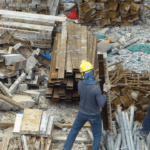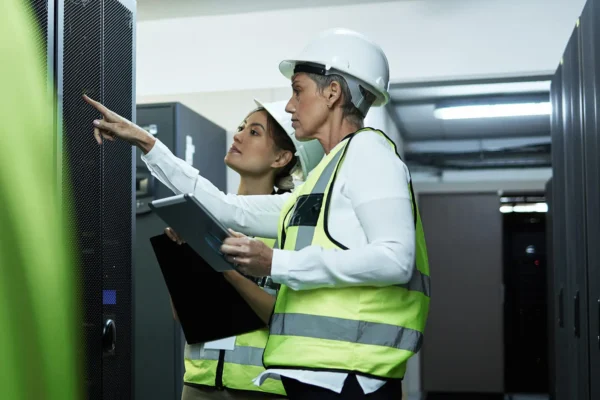7 Hazard Elimination Examples
As someone who is responsible for health and safety in your workplace, you want to do whatever you can to reduce the risk of harm to yourself, and those you work with. That means eliminating hazards where possible.
You are in the best position to work out what ‘eliminating hazards’ means to your business. The hazards you face will vary widely depending on the field you are working in, and you will need to conduct a risk assessment to identify the specifics for your context. But what kind of hazards can you expect to be dealing with?
This post will give you 7 hazard elimination examples in different work contexts, to give you a better idea of what works.
Construction site hazards:
If your work involves any kind of building, demolishing, or other physical work, you will likely face a variety of physical hazards, such as:
- Working at height
- Falling objects
- Moving objects and vehicles
- Structural collapse
- Harmful materials
- Manual handling
When in doubt, cut it out. For example, you can eliminate hazards such as manual handling by using alternative, mechanical, means of lifting, moving, or operating heavy or unwieldy loads, or by splitting a bulky load into smaller, more manageable parts. If a hazard can’t be avoided completely, you can minimize risk by providing training, restricting access to hazardous work, and providing Personal Protective Equipment (PPE).
For more information you can check the HSE Construction page.
Telecoms industry hazards:
This field covers a broad area of vital networks of connectivity, from telecommunications masts to setting up modems and internal networks. Typical hazards could include:
- Working at height (e.g. telecoms masts and towers)
- Electrical hazards
- Inclement weather
- Equipment failure
- Structural collapse of towers
One simple way to eliminate the risk of inclement weather is to make it a rule to suspend any activities that involve working at height until the weather improves. You should also provide appropriate training and protective equipment to ensure that only qualified and well-prepared workers have access to risk areas.
The Masts and Towers Safety group (MATS) have a wide range of resources to help you.
Warehouse hazards:
If your business concerns storing and shipping goods or equipment, there are a variety of common hazards that you are likely to encounter. Your warehouse might have some of the following hazards:
- Forklifts
- Loading docks
- Conveyors
- Storage systems
- Manual handling
- Falling objects
- Slips, trips, and falls
- Fire hazards
- Energized Equipment
To eliminate hazards such as falling objects, you should make sure that your storage systems are secure and appropriate to the load. Avoid unbalanced and loose loads, and make sure that hard hats are provided, as necessary. You should also make sure that specialized equipment such as forklifts and conveyors are only operated by trained employees who have full and proper protective equipment, and hazards such as loading docks are clearly signposted to keep people away from risk.
Catering and hospitality:
If your business involves food or hospitality services, there will likely be hazards that present risk to both your workforce and members of the public. Watch out for:
- Slips, trips, and falls
- Cleaning chemicals
- Manual handling
- Knife accidents
- Poor ventilation and extreme temperatures
- Cooking equipment
- Biological hazards and germs
- Dermatitis
Some hazards, such as a water spill on a tiled floor, can be eliminated quickly and easily, while others will need more attention. You might decide that the best way to eliminate a hazard such as knife accidents for kitchen staff is to outsource knife sharpening to a specialised service, or that some hazardous chemicals can be replaced by safer alternatives. Always make sure that food-preparation storage and preparation areas are in a hygienic and sanitary condition, to prevent bacteria developing.
Retail environment hazards:
If you are managing, supervising, or working in a retail environment, you are not only dealing with the movement, inventory, and storage of goods, but also staff and customers. There are a number of possible hazards you need to consider:
- Blocked exit routes and pathways
- Slips, trips, and falls
- Unsafe storage
- Unstable loads
- Fire hazards
- Manual handling
- Violence and aggression
- Stress and bullying
You should eliminate any hazards that block passage and access to exits by removing all obstacles and barriers from the necessary areas. Make sure that goods are stored safely and efficiently – if you notice that a shelf or pallet is broken or uneven, move the stock from it to a safer location. If there is a high risk of customer violence and aggression, you might provide a barrier to protect your staff, and training in how to de-escalate or escape a potentially dangerous situation.
Office environment hazards:
Offices may be considered low-risk working environments, but there are still a variety of things to watch out for, including:
- Slips, trips, and falls
- Poor workstation ergonomics
- Eye strain
- Fire safety
- Electrical hazards (e.g., appliances and power outlets)
- Poor lighting or indoor air quality
- Spread of contagious illnesses
- Stress hazards
You can eliminate the risk of musculoskeletal injury or illness caused by poor workstation design by replacing certain elements with more ergonomically efficient substitutes. Encouraging frequent screen breaks will reduce the risk of eye strain. Keep an eye open for unnecessary and continual use of extension or multi-socket power cables. You may need to hire someone to install a fresh permanent outlet to eliminate that hazard, if necessary.
Human Resources hazards:
Whether you work in HR, management, or as a supervisor, the wellbeing of the people you work with is paramount. Not all hazards are purely physical. Psychosocial hazards that cause stress and emotional distress can result in injury, illness, poor health and behaviour, as well as disengagement, absenteeism, and resignation. You should be careful about things such as:
- Unreasonably high/low work (emotional, mental, physical) demands
- Excessive time pressure
- Long or unpredictable hours of work
- Low control over work situation
- Poor support or supervision
- Lack of role clarity
- Poorly managed organizational change
- Interpersonal tensions (including bullying and harrassment)
- Low levels of recognition and reward
- Remote and isolated working conditions
- Violence and trauma
- Organisational injustice
You should do whatever you can to help people feel safe and comfortable in going about their work. To eliminate the stress of long or unpredictable hours, for example, you could establish a clear rota system that establishes shifts and reasonable hours of work. You will also benefit from offering training to managers and supervisors in how to delegate and give constructive feedback to workers, and consider effective conflict-resolution strategies.
Hazard elimination is the best way to prevent harm to the people you work with. Taking the time to identify which hazards can be avoided, and taking the appropriate measures to remove or neutralize any risk, will be well worth the effort. The worst kind of workplace incident is one that could have been avoided, so make sure you know what hazards apply to your work context, and think about ways to deal with them.
Don’t forget to keep clear lines of communication open, and show that you value your workforce. They might know about hazards that you aren’t aware of, and they need to know what you are doing to protect them!
We hope you’ve found these hazard elimination examples helpful. Do you have any questions about how to eliminate hazards in your workplace?
Comments (2)
Comments are closed.






Daniel Connell
November 30, 2020Thank you for the helpful information you’ve shared with us! Taking precautions while working can save lives and prevent serious injuries. It is a good idea to have a height safety training Mackay if you are working at heights to know the safety precautions and hazards that can happen while working.
Fortune Khumalo
March 7, 2021Thank you very much for supplying with such an information. for sure a hazard should be removed from the workplace to ensure that others are not put at risk and the only effective way to do this is by elimination.